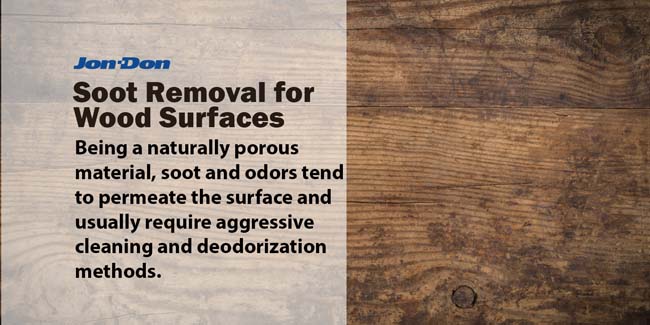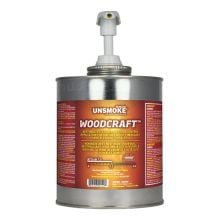
How to Remove Soot from Wood Surfaces
Soot damage cleanup on wood can be particularly challenging. Being a naturally porous material, soot and odors tend to permeate the surface and usually require aggressive cleaning and deodorization methods.
There are typically two types of wood that professional restorers are tasked with cleaning. Each type of wood requires specific soot removal products and procedures.
Finished Wood
Wood that is covered in a sealer or varnish. Most types of wood furniture (desks, dressers, tables, cabinets, railings, etc.) are finished wood pieces. Soot damage cleanup on this type of surface involves a cleaning agent that is gently worked into the grain of the wood where it suspends the soil for easy removal.
Unfinished Wood
Has no sealer or varnish, and it is far more susceptible to damage from smoke odors and staining from soot. Unfinished wood generally includes structural wood and the insiders of drawers and cabinets. Unfinished wood may also be prone to water stains, so care must be taken during cleaning and restoration efforts.
Most often sealing the surface of the wood (whether it is finished or unfinished) will be necessary to lock away odors. If the property owner does not want an unfinished wood surface to be sealed (such as the walls of a log cabin or wood beams exposed for architectural aesthetics), cleaning and deodorization can be particularly challenging. Complete soot and odor removal should not be guaranteed.
Restoration of Finished Wood Damaged by Soot
Finished wood is covered with a layer of varnish or protective coating. When involved in a fire or smoke damage situation, damage around the handles is a common pre-existing condition which should be documented.
Basic Procedure:
- Dry Cleanup of Soot
- If the soot residue has no oils, use either a lambswool duster or HEPA vacuum on all surfaces.
- If the soot reside is mostly dry, you can use a chemical sponge (dry cleaning sponge) to clean the gross soot residue. Pay careful attention to not put a lot of pressure on the sponge as this may permanently embed the soot residue into the pores of the finished wood.
- Using Murphy Oil Soap or Wood Cleaner and cotton rags, clean all wood.
- If more agitation is needed, you can use 0000 grade steel wool. Remember, if using steel wool, only work in the direction of the grain.
- In extreme situations, you can use a weak dilution of Unsmoke Degrease-All. Rinse well after cleaning.
- Polishing after cleaning may be required. If you used a degreaser at any point in the cleaning, this step is a necessity.
Cleaning Unfinished Wood Affected By Soot
Do to the different roughness and materials of the unfinished wood along with the different pressures and temperatures of fires, you may need to try any or all of these suggestions. It is often desirable to seal the wood after cleaning.
Basic Procedure:
- Remove all heavily charred areas if possible.
- Using either Unsmoke 9-D-9 or FreshWave IAQ Air and Surface Spray, suppression spray all areas for initial odor knockdown.
- HEPA vacuum all surfaces to remove dry soot.
- Wipe all surfaces with a dry cleaning sponge (chemical sponge) to remove gross amounts of soot residue.
- Using a degreaser (diluted to label instructions), apply to untreated wood using a pump-up sprayer. Agitate using a nylon brush. Rinse with clean water. A deodorizer may be added to your cleaning solution for extra deodorization.
- Hand sand any heavily stained areas. This may lessen or remove the stain.
- Thermal fog the area, using the right scent for your application:
- Electrical and plastic fires - Kentucky Bluegrass
- Protein fires - Citrus/Lemon
- Natural fires - Neutral (Unscented)
- Combination or aggressive odors - Cherry
- If any odor persists, use either an ozone or hydroxyl generator in the affected area.
Alternate Procedure:
For large areas you might want to forego the above recommendation in steps 1 through 6 and use a media blaster for quicker results.
Wood Furniture Restoration
If wood has been burned, it will probably need replacement.
Directions:
- Using a pump-up sprayer apply Unsmoke Degrease-All diluted at 14-43 oz per gallon of water. Use minimal moisture in applying it.
- Use dry cleaning sponges to remove loose soot evenly.
- Using a cloth rag, apply Woodcraft Cleaner over the vertical and horizontal surfaces working with the grain of the wood.
- Let Woodcraft Cleaner dwell for 5 to 10 minutes to soften the oily soot.
- Using 0000 steel wool, agitate surface with wood grain gently polishing off smoke staining.
- Wipe excess restorer of with terry cloth towel. Wipe in the direction of the grain.
- With a cloth rag, rub Unitex Luster Lemon Oil Polish into the wood.
- If odor remains, place furniture in ozone vault and let sit for 24-48 hours.
For more information or assistance in selecting products for your restoration job, please contact a Jon-Don Restoration Specialist at 800-556-6366.


We pay the shipping charge, including hazardous material fees, on this item. There's no catch. No "buy this to get that" requirement.
Note: If your order contains items that are not eligible for free shipping, your order total will include our competitive shipping rates for those non-eligible items only. This shipping policy only applies to orders shipped within the Contiguous U.S.


